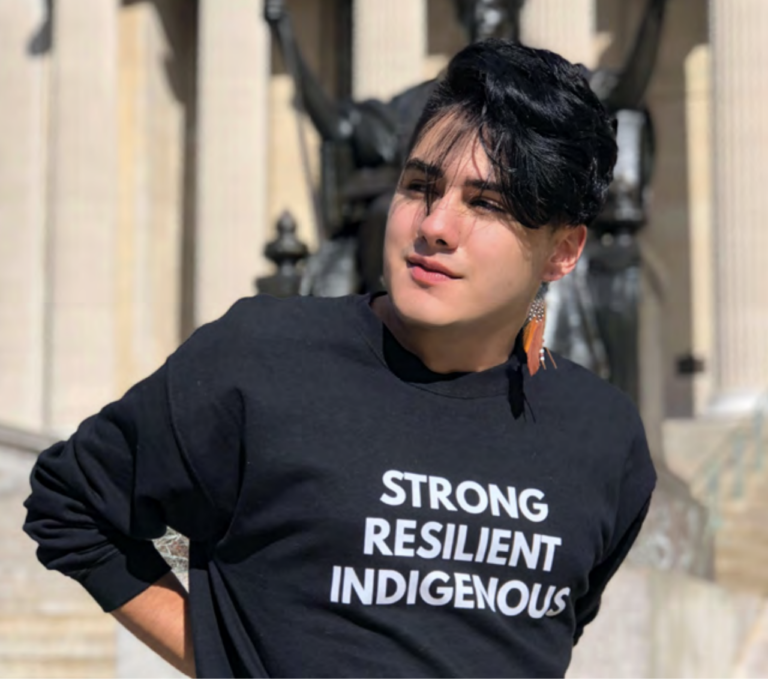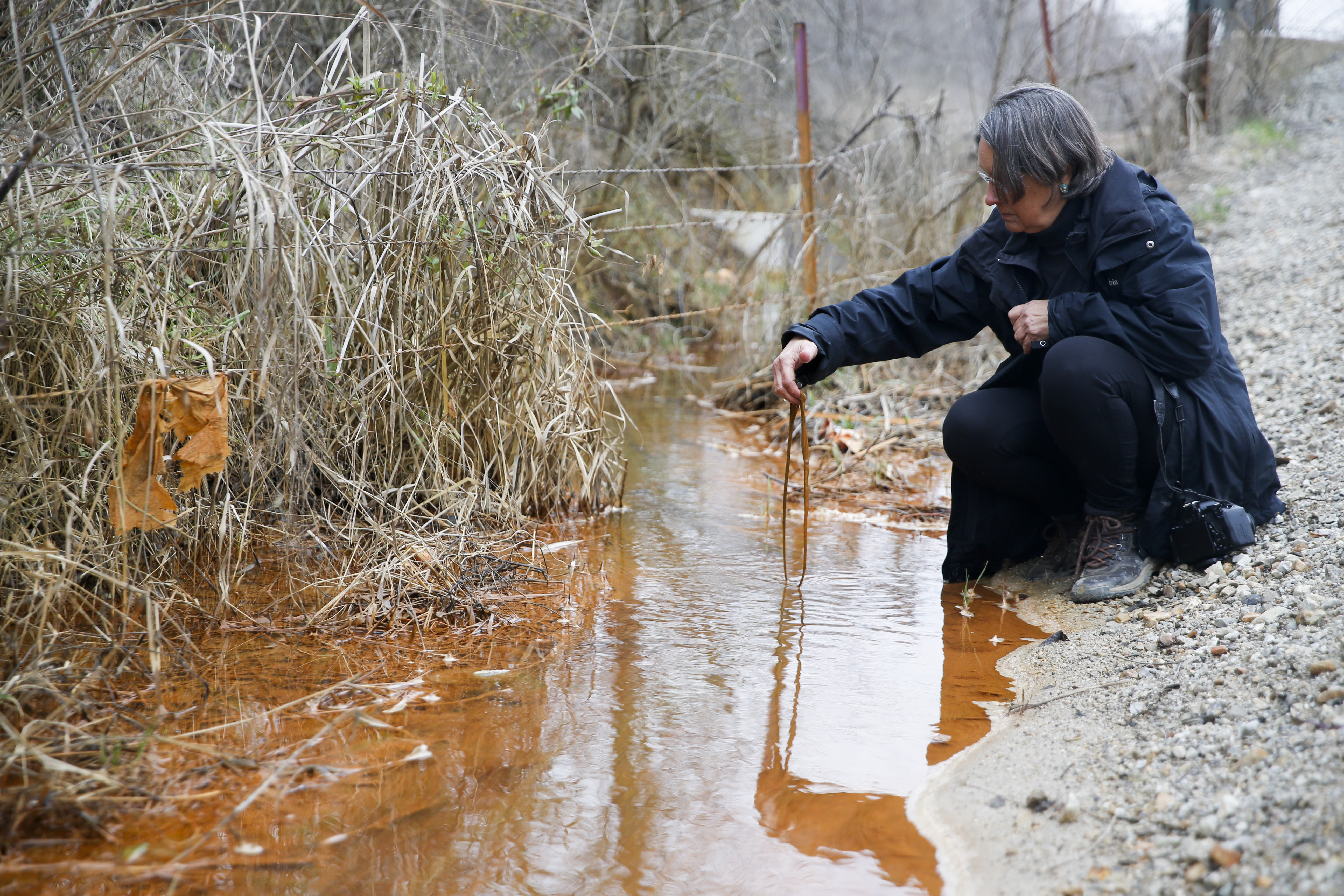United States: ‘If we continue to place our own individuality at the centre of our existence we will collapse on ourselves’
By: ajcarapella

By Alicia Kroemer. Originally published by Minority Rights Group International in Minorities and Indigenous Trends 2020: Focus on Technology.
Featuring James Walkingstick (above), LEAD Agency’s youngest Board member. It also features the history and creative principle LEAD (home to Tar Creekkeeper and Grand Riverkeeper) was founded on, “Gadugi.” James (Cherokee) is also a Harvard undergraduate student. LEAD has additional tribal members on its Board including an elder who was the first Chairwoman of the Quapaw Nation.
James Walkingstick is a young activist from the Cherokee Nation, currently working, alongside his social anthropology studies at Harvard University, as a board member for LEAD Agency (Local Environmental Action Demanded, Inc.). This group advocates for environmental justice in north-east Oklahoma, focusing on Tar Creek. A legacy of lead and zinc mining, as well as asbestos pollution, has resulted in its designation as one of the first and worst of the country’s ‘superfund sites’ – extremely hazardous areas where clean-up is funded by the Environmental Protection Agency (EPA). He shared with Alicia Kroemer the value of Gadugi, a Cherokee word which embodies a vision where multiple generations come together and harness indigenous knowledge to address global issues.
How does LEAD Agency apply traditional indigenous knowledge to address current issues like climate change?
LEAD Agency was founded in 1997 as a response to the Tar Creek Superfund Site. This site was the largest lead producer during the First World War, supplying over half of the bullets used in the war. The mine shafts were abandoned shortly after the Second World War and they flooded with water. In the 1980s, water began seeping out of the shafts and into our local creeks. This water was contaminated with cadmium, zinc and lead — all of which are highly toxic pollutants. The water subsequently oxidized and turned red, which led those living in this area to become ill. We are deeply concerned about the health risks associated with water heavily contaminated with lead.
LEAD Agency fought against the contamination and worked to protect citizens and our water source. LEAD took up the initiative to get the EPA involved, bringing in the government and various organizations to clean the Tar Creek Superfund Site. It happens to be in a location where over ten tribes reside. The contamination directly and disproportionately affects Native Americans. The Cherokee Nation founders of LEAD — Rebecca Jim and Earl Hatley — wanted to implement their indigenous knowledge by working together as a community to do the clean-up.
The indigenous knowledge that the founders strongly pushed was Gadugi, which is the Cherokee value of coming together as one and working together to accomplish a goal. This value has been with our people for millennia. Our people came together to harvest crops, settle negotiations and build networks with this value. Even the root of the word, Gadu, means bread — a food item that requires collaboration to craft.
Through Gadugi, our agency has been able to reach out and achieve positive outcomes for all tribes involved. We have been able to make it a harmonious, collaborative effort. While the site is on Quapaw tribal land, all surrounding tribes are getting involved and helping LEAD Agency push the issues to the forefront. We are bringing in other agencies, like the Department of Environmental Quality and the EPA.
As for innovation, the Peoria Tribe has invested nearly US$400,000 in a new medical centre for Native nurses, along with upwards of US$1 million in scholarships. The Cherokee Nation, Modoc Nation and Quapaw Nation all possess prospering herds of bison, with the hope of nurturing a growing industry.
Through the value of Gadugi, we have been able to come together and protect our water, our most sacred relation. The Cherokee people are people of the creek — we go to the water for ceremony. We use water in our everyday life; clean water is vital for our communities. We have taken every action to protect it. To negate pollutants, we have also implemented food sovereignty. The site has created giant piles of toxic chat around Tar Creek — waste produced from lead mining. These chat piles have spread enormous amounts of poisonous dust around the area and many local crops are affected. This means our food sources remain at high risk. We use food sovereignty as a way of counteracting this. We aim to control what we eat through growing traditional indigenous foods that sustain us. We are using the methods that we have always known in our communities. If a yard is contaminated with lead but a person wants to grow vegetables in their garden, we raise crops up by one or two feet above the soil to keep them safe, using mulch and compost as counteragents. This is ancient indigenous knowledge being practically applied. By using this knowledge today, we are able to combat lead contamination.
We are also trying to solve the issue of massive environmental inequality on tribal land. A recent study by the EPA found that our traditional plants (arrowroot and duckweed — found along Tar Creek) contain over 7,000 times the safe amount of lead, compared to baseline plants. These plants are consumed only by Native Americans. Our alleyways and playgrounds have been paved with chat. Recent studies have shown that a third of our Native youth have been diagnosed with lead poisoning. We know we need to advocate for ourselves and our tribal communities.
In terms of technology, innovation and access, how can traditional indigenous knowledge be applied in each category?
There are myriad ways we can implement what we know, but I think the heart of it is our sovereignty. If we want to be innovative, create access and use our technology for a sustainable future, we need to look at our sovereignty first as nations. Our connected tribes have been reaching out in new ways to create a better future. With regard to technology, look at our use of solar panels: the Quapaw Nation has been building them on tribal land, especially around the superfund site. We have already recovered over 800 acres of polluted land by remediating the soil and eliminating the presence of toxic chat. We are creating new ways for sustainable energy for the tribe. The Cherokee Nation uses hydroelectric power with the world’s longest multi-arched dam. Through the Pensacola Dam we can provide tribal citizens with hydroelectric power and fight our reliance on fossil fuels to power homes.
LEAD Agency is playing a direct role by advocating for communities upstream of the dam, ensuring we receive clean energy and safe lake levels. We have been pushing toward a future that is combating climate change. As for innovation, the Peoria Tribe has invested nearly US$400,000 in a new medical centre for Native nurses, along with upwards of US$1 million in scholarships.
The Cherokee Nation, Modoc Nation and Quapaw Nation all possess prospering herds of bison, with the hope of nurturing a growing industry. We are all working together. While the value of Gadugi is a Cherokee value — it connects all tribes and nations. We are carrying that same value by different names. The sovereignty that we use can push us forward, push us away from fossil fuels, push everyone into a cleaner future.
Another Cherokee value that we hold is Detsadaligenvdisgesdi, the value that we take responsibility for each other. We watch out for one another and highly value the wellbeing of one another. It is not limited to our tribe or our identity: this is a value which is universal, timeless and necessary for the survival of humanity. This responsibility is vital for our future and for addressing inequality. If we continue to place our own individuality at the centre of our existence we will collapse on ourselves. It is through Gadugi and caring for our community that we truly thrive and survive. You must have that right mind and heart to combat inequality.

‘Involving our youth in sustainability and teaching them our values is extremely vital. If we want a clean future, we cannot just focus on ourselves in the moment, we need to focus on how we transmit these values to the next generation – from Elders to youth.’ – James Walkingstick
Why is it important that the next generation of indigenous youth prioritize transmission of knowledge in addressing modern problems?
Our youth are the future. Within North American tribes, we share the value of the seventh generation (though by many different names). It is an inter-tribal value that we must care for the seven generations ahead. It means creating a positive future for your children and your children’s children; to create an environment where they can sustain themselves. Involving our youth in sustainability and teaching them our values is extremely vital. If we want a clean future, we cannot just focus on ourselves in the moment, we need to focus on how we transmit these values to the next generation — from Elders to youth.
This is a problem that we face here in the Cherokee Nation, due to language loss. Our language has been diminished by colonial institutions and because of this we have lost many of our values and traditional knowledge. Right now, we are cultivating a comeback and building on language preservation programmes. Last year we lost our last monolingual Cherokee speaker, Mack Vann.
When we lose our language, we lose our values, and we lose Gadugi. When we teach youth our language, they learn the values inherent within our culture — what our people have been doing for thousands of years. When our youth step up and reach out they help the community in so many ways. We will have a bright future ahead of us if the youth know their values and build on that knowledge, applying it into the future. The pathway to a sustainable future is rooted in Gadugi, turning from individuality to the collective. Even if we feel alone, we are a part of the community of humanity, who have the privilege of existence on this planet. Let us live through Gadugi and care for each other — by ensuring green and sustainable practices are the default global shared value — for those who will be living on this planet when we no longer are.